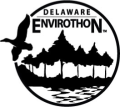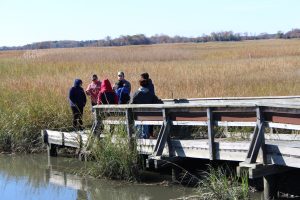Visit a wetland in the vicinity of your school. Evaluate it relative to wetland functions and values. Identify what type of wetland you think it is. Make a list of the plant and animal species you can identify from this wetland area. Examine the surrounding land uses for potential human impacts on this wetland.
Using a map of Delaware, locate bodies of water that are most likely to support particular fish and shellfish species of both the fresh and saltwater type. Visit one of those water bodies, seine for fish, and use field guides to identify what you catch. Inland Bays of Delaware are showing high levels of nutrients in the water. Visit a Bay or pond and test nutrient levels and discuss the possible sources of nutrient enrichment, as it relates to point/non-point pollution types. Consider the potential effects of this on aquatic and human life in that area, and what might be done to help reduce the problem for the future.
Obtain a topographic map that encompasses your school area. Locate your school on the map and the nearest water body to which the land it occupies drains. Trace this connection to larger and larger water bodies, and ultimately to the Delaware Bay, the Chesapeake Bay and Atlantic Ocean.
Sample Questions
- Which of the following Delaware River fish is not an anadromous one?
- flounder
- shad
- Striped bass
- sturgeon
- menhaden
- Which of the following statements about high nitrates levels in a body of water is FALSE?
- They might be caused by heavy use of soil fertilizers in that watershed.
- They can contribute to high turbidity and low dissolved oxygen levels in the water.
- They would tend to result in high biodiversity levels in the macroinvertebrates community.
- They can result in soupy-rich blooms of algae and other aquatic plants.
- The most important piece of legislation for wetland protection at the national level is the _____________________________ Act.
- The basic idea of biomagnification of pollutants is that the _______________ that an aquatic organism is the more it accumulates certain toxic pollutants found in the water.
- the lower on the food chain
- the lower down in the water
- the higher on the food chain
- the more complex and developed
- Regulations often require that a fish be of a certain minimum size before it can be legally harvested. What is the biological basis for such regulation?

